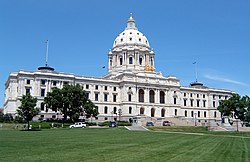| Seventy-eighth Minnesota Legislature | |||||
|---|---|---|---|---|---|
| |||||
 | |||||
| Overview | |||||
| Legislative body | Minnesota Legislature | ||||
| Jurisdiction | Minnesota, United States | ||||
| Meeting place | Minnesota State Capitol | ||||
| Term | January 5, 1993 – January 3, 1995 | ||||
| Website | www | ||||
| Minnesota State Senate | |||||
| Members | 67 Senators | ||||
| President | Allan Spear | ||||
| Majority Leader | Roger Moe | ||||
| Minority Leader | Dean Johnson | ||||
| Party control | Democratic-Farmer-Labor Party | ||||
| Minnesota House of Representatives | |||||
| Members | 134 Representatives | ||||
| Speaker | Dee Long, Irv Anderson | ||||
| Majority Leader | Alan Welle, Irv Anderson, Phil Carruthers | ||||
| Minority Leader | Steve Sviggum | ||||
| Party control | Democratic-Farmer-Labor Party | ||||
The seventy-eighth Minnesota Legislature first convened on January 5, 1993. The 67 members of the Minnesota Senate and the 134 members of the Minnesota House of Representatives were elected during the General Election of November 3, 1992.